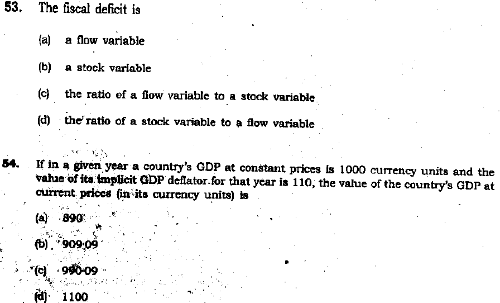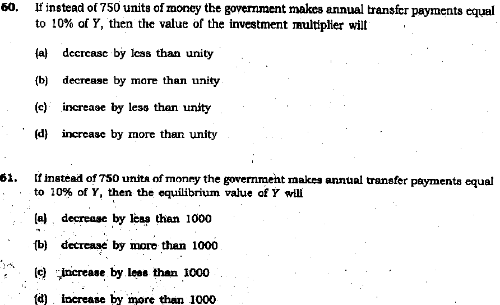JNU ECOM 2010 QUES 51-61
12
12
|
QUES 51
 Answer-d QUES 52 The rate of interest is : a. a flow variable b. a stock variable c. the ratio of a flow variable to a stock variable d. the ratio of a stock variable to a flow variable Answer-b  Answer 53-a 54-b QUES55 Suppose the difference between the transactions velocity and the income velocity of circulation of money in an economy is 5 and the money value of total transactions is 6 times the money value of aggregate income. If the quantity of money in circulation is 1000 currency units, then the money value of aggregate income in currency units is : a.1000 b.1200 c.1500 d.1800 Answer-a QUES 56 Suppose an asset provides returns of Rs 315 after one year, Rs 661.50 after two years and Rs 1389.15 after three years & nothing thereafter.If interest is compounded yearly and the rate of interest is 5% per annum, what is the present discounted value of the asset? a. Rs 2,050 b. Rs 2,100 c. Rs 2,200 d. Rs 2,250 Answer-b QUES 57 Suppose a plant can be used to produce in a day x units of product 1 and y units of product 2 where y=(32-5x)/(10-x), where 32/5 <,= x >,=0 ( weak inequality ). If the unit price of product 1 is twice of the unit price of product 2, then to maximize total revenue the number of units of x the plant should be used to produce in a day is: a. 4 b. 5 c. 6 d. 6.4 Answer-d The next four questions 58-61 are based on the following : Suppose, in equilibrium, aggregate income (in units of money per year) in an economy Y=C + I, where investment expenditure ( in units of money per year ) I = 1000 and aggregate consumption expenditure(in units of money per year) C satisfies the following: (i) C is a function of current disposable income in the economy :Yd (ii) If Yd = 0, then C = 500 (iii) Marginal propensity to save out of Yd is constant in the economy and equal to 30% Suppose the government collects direct tax revenues equal to 15% of Y and makes direct payments equal to 750 units of money per year. QUES 58 What is the value of Investment Multiplier in the economy? a. Between 1.9 & 2.1 b. Between 2.1 & 2.3 c. Between 2.3 & 2.5 d. More than 2.5 Answer-c QUES 59 What is the equilibrium value of Y in the economy? a. Between 3250 & 3750 b. Between 3750 & 4250 c. Between 4250 & 4750 d. Between 4750 & 5250 Answer-d  Answer 60-c 61-a |
|
Please confirm the answers..
i am not sure about 51,54, 55 |
|
In reply to this post by Arushi :))
Answer of 52 is a
int rate cannot be measured at a point of time |
|
In reply to this post by Arushi :))
I get option (b) as answer for 59th question. The way I worked out is illustrated as below. Please comment, if there is any problem in my approach.
I=1000 C= c(Y-T+Tr) = 0.7(Y-0.15Y+750) = 0.595Y+525 Y= C+I = 0.595Y+525+1000 0.405Y=1525 Y=3765.3775, which lies between 3750 and 4250 |
|
hi Ibrahim.
You have done a silly mistake here. Its given that when Yd is 0 then consumption is 500. So the consumption function would be Y = 500+ c(Y-T+Tr) Rest is correct In the end what we get is Y= 2025+ 0.595Y which will give the Y= 5000. Hence the answer is part D |
|
In reply to this post by Arushi :))
I think, ans to 54) d
since gdp def=gdp at current prices(nominal gdp)/ gdp at constant prices(real gdp)*100 gdp at current prices=110*1000/100=1100 |
|
In reply to this post by Arushi :))
Thank you, Arushi.
I really forgot about the autonomous consumption component. |
|
In reply to this post by bhavya jain
thanks bhavya..:)
i mistakenly took Real GDP in the numerator  thankyou |
|
In reply to this post by Arushi :))
Hey Arushi!! Can you please explain the solution of Q. 55??
|
|
Okay. For ques 55.
we have to use the equation MV=PY For the transactions velocity of money , we have to include value of all the goods - intermediate, final goods However for the Income velocity of money, only the value of final goods is included. So that way we get two equations i) M x transactions velocity of money = value of all goods ii) M x income velocity of money = value of aggregate income Vt-Vm = 5 => Vt= 5+Vm Let the value of aggregate income be X. value of total transactions = 6X M x (5+Vm) = 6X M x Vm= X Dividing the first equation by second: (5+Vm)/Vm=6 => 5Vm= 5 Therefore, Vm =1 M = 1000, n from equation (ii) we get value of aggregate income = 1x 1000 = 1000 Hence, part a |
|
Okay!! Thankyou so much!! :D
|
|
In reply to this post by Arushi :))
Arushi why have you taken interest rate as a stock variable ? Shouldn't it be flow ? And how did you solve 51 ? Sure of its answer ?
"Once you eliminate the impossible, whatever remains, no matter how improbable, must be the truth."
|
|
In reply to this post by Arushi :))
hi..is there a formal way of doing 52?
|
|
I guess common sense should work here. Like , interest rate is not valued at a particular point of time , it is rather calculated for a given time frame. Iam really in doubt that why arushi has marked it as b
"Once you eliminate the impossible, whatever remains, no matter how improbable, must be the truth."
|
|
It should be b for 51
|
|
Whats the logic behind it noel ?
"Once you eliminate the impossible, whatever remains, no matter how improbable, must be the truth."
|
|
x<y+€
x-y<€ for all €>0 this condition definitely holds true for all x<y also if x=y then x-y=0<€ for all €>0 from both these cases we see that x=<y but x can't be greater than y for if x>y then x-y>0 let x-y=k where k>0 choose €=k/2>0 hence x-y>€ which is a contradiction so x=<y |
|
@ noel
b is wrong by contradiction, let x be 5 and y+€ = 5.04 Then it could well be the case that y is = 4.99 and € is 0.05 And that doesn't imply that x <,= y ! Only for d , there cant be a contradiction, x<0< y implies x is always negative and y is positive and greater than x . So whatever € > 0 is added to y it will always be greater than x |
|
This post was updated on .
Well you've restricted the value of € to 0.05 whereas the question says that the inequality should hold for all €>0
in the example that you gave y=4.99 now take €=0.001 which gives y+€<x it certainly cant be d because let x=y=1 now whatever be the value of €>0 x<y+€ |
|
But d says x<0<y
zero lies between these two numbers and this means x is negative and y is positive, so for all € > 0 this will hold !! However, in all the other cases if we take both x and y positive , it doesn't imply anything with surity, |
«
Return to General Discussions
|
1 view|%1 views
| Free forum by Nabble | Edit this page |

